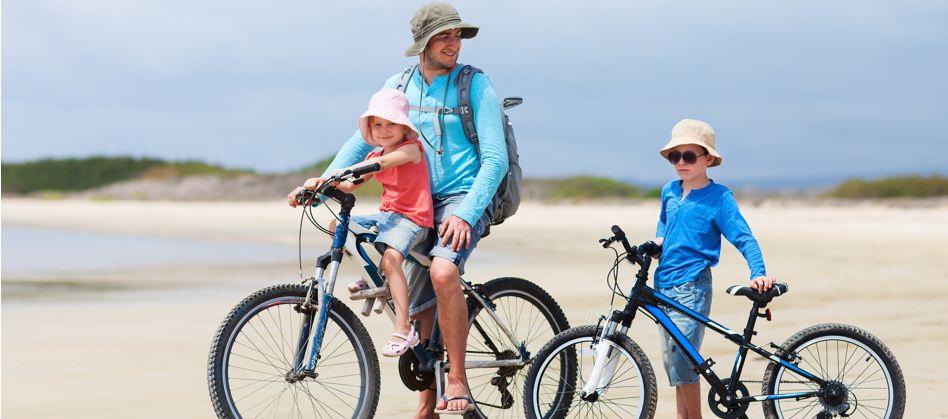No. 1 - Travelling in the Car

Travelling Doesn't Have to be Boring
Introduction to Activities With Children
Parents who are committed to the intellectual, emotional and social development of their children will have to make sacrifices. While parents do this, they will also grow intellectually, emotionally and socially. Everyone will have an opportunity to expand their knowledge base. Nature provides us with many lessons that help in the maturation process.
ENCOURAGING A LOVE OF BEAUTY AND THE NATURAL WORLD
It is essential to create in children an appreciation for the beauty, organisation, and inter-dependency found in the natural world. Of Nature creates interests that can benefit one for a lifetime. Your enthusiasm will infect your children. Being in nature and contemplating it, has a calming effect, elevating positive moods and lowering stress and anxiety.
FOSTERING INTELLECTUAL, SOCIAL AND EMOTIONAL DEVELOPMENT
The activities and games described below will not be appropriate for all age groups. Some can be modified to suit different ages. Activities in small groups involve communication, organisation, problem-solving and cooperation. The suggestions below are not exhaustive but are starting points. Be creative, modify these activities to suit and think of many other games and events that teach, occupy and amuse your children. Many of the games and activities are suitable in different circumstances, e.g. at the beach, in the bush or at home.
POSITIVE CHARACTER ATTRIBUTES
The positive character qualities, communication skills, social norms, skills and knowledge that are fostered by involvement in the activities are numerous.
Travelling in the Car
NOTE
Try to restrict, or better eliminate, the use of mobile phones, electronic games, and videos while travelling. They have a detrimental impact on children's intellectual, physical and social development. Be aware that these devices can become addictive and fewer children will enjoy the 'simpler things of life'.
MAP READING
When they were old enough, we obtained for our boys' detailed maps of the route we were taking. They could:
- See how far it was to the next town
- Know the name of the next town
- Find out when we were about to cross a river
- Know what direction we were travelling
- Calculate the distance to our destination
- Learn many mapping skills for themselves
TWENTY QUESTIONS
One person thinks of an object they can see. The others have twenty guesses to discover what the object is. The person who is 'in' can only answer 'yes' or 'no'.
I SPY
"I spy with my little eye something beginning with B." The others try to guess what the object is. The person who is 'in' can only answer 'yes' or 'no'.
NUMBER PLATES
Each person chooses a numeral between Zero and 9. The driver says, "Now!". He calls out the numbers on the number plate of the next car that comes into view, coming towards them. Each person scores a point that chose a number that was on the plate. Multiple numbers score multiple points, e.g. if a person selects 5 and the number plate was 525 that person scores two points. The first to ten points wins. Play the same game with the letters on the number plate and later talk about the probability (likelihood or chance) of guessing numbers compared with letters.
CHILDREN CAN MAKE UP GAMES
Some kids can be very creative and often come up with games they like better than the ones you might suggest.
GUESSING THE ARRIVAL TIME
Before setting out on a trip, each person imagines the time they think they will arrive at the destination. Beforehand it is wise to decide which timepiece to use. The person who is closest to the actual time washes the car!! Don't tell them that until you arrive. Our family played that game on a trip from Toowoomba in Qld, to Newcastle in NSW, a distance of about 730 km (456 mi). Would you believe it? We rolled into the driveway and stopped. We had arrived at the exact minute that I had guessed. We all couldn't believe it. Everyone was so excited because it seemed so impossible for anyone to guess the time of the trip to the exact minute.
COUNTING SEMI-TRAILERS
On the way back from Newcastle to Toowoomba, two of our boys decided to count the number of semi-trailers (big trucks) they saw. There were about 395. There are lots of things kids can count. It's an excellent opportunity for them to practice tallying, "One, two, three, four, five." Four down strokes with a horizontal line drawn through them on five, and repeat.
ROAD RULE INSPECTORS, SPOT THE BAD DRIVER
At the beginning of the trip 'swear in' the children as road-rule inspectors. The children report to the others when they observe someone breaking a road rule, e.g. speeding, parking illegally, dangerous driving, not stopping at red lights, car lights not working, etc. The driver of the car will have to concentrate, or they might be embarrassed by their observant five-year-old watching the odometer :) Teach your children the road rules while you are travelling.
SPEED SIGN PATTERNS
Children record the numbers displayed on consecutive speed sign. Ask them to look for any patterns.
PETROL PRICES
Children record the town, brand and petrol prices of service stations along the way. They can compare the prices to see which is the best place to buy fuel on the way home.
PATTERNS
Spend some time looking for patterns and pointing out how the parts make up the design. Fences are a good place to start.
WILDLIFE
While children are young, they enjoy learning the names of things. Learning the names of birds, animals, insects, flowers etc. builds up a child's knowledge base and sense of mastery. It adds to their confidence when they can name them. Instead of toys, sometimes it is a good idea to buy the reference books for identifying different categories of wildlife, e.g. birds. It doesn't take long for children to know enough to find something interesting wherever they go.
SINGING
Children like to sing. Even if some can't keep in tune, it is another shared experience that passes the time and is bonding. Simple songs are excellent, but it would be wise to adjust the type of songs to the ages of the children. If you have teens they might not like your choice of 'Twinkle, Twinkle, Little Star' or 'Old McDonald Had a Farm'. Then again they might :)
LISTENING TO MUSIC:
Classical music and instrumental music with melody and harmony are the best music for intellectual development. Loud, shouted songs with poly-rhythmic and heavy beat backing, do the reverse. Every committed parent should be aware of the words of these upbeat songs; they do impact the listener's psyche.
More on this in the future.
NOTHING TIME
Now and again have a 'Nothing Time'. These are short times, maybe from one to ten minutes, when everyone tries to make no sound at all. All, except the driver :) closes their eyes and listens carefully, trying to remember all the sounds they hear. After a time everyone takes a turn to report what they heard. Young children develop a sense of the passing of time, can estimate time more accurately and improve their auditory memory.
READING SIGNS AND SHOP NAMES
Travelling is an excellent opportunity to help children with their reading skills. In towns, there is plenty to read. Choose big signs that are easy to see a long way off. "What is the second word in the sign on the left?" Sound out words with younger children when you have a rest stop. Find words the children can touch. Run your finger under the word saying the syllables as your finger runs under them. Encourage the child to copy you. Be careful not to overdo structured activities.
LEFT AND RIGHT
Using a finger, parents point out interesting things to the children. "Look at that black horse on the right." "Look to the left. Can you see the big dam?"
THINGS YOU CAN DO AT STOPS
There are many things you can do at rest stops, apart from eating, drinking and going to the toilet.
- "Look at people's faces and see if they look sad, mad, glad or bad." (Emotional awareness)
- "What creepy crawlies can you find?"
- "Collect three interesting rocks. Make sure they are little ones and not out of McDonald's rock garden."
- "What litter or vandalism can you see? How does it make you feel?"
- "You only have three minutes. See who can take the best nature photo."
STOP CREDITS
At the beginning of a trip give each child a five minute stop credit, so they can stop and look at something they see along the way. You might consider giving more credit minutes, taking into account the length of the trip and the number of children in the car.
ROADKILL EMPATHY
Have children take note of the types of animals that are killed by traffic. Discuss suffering, affect on mates, spoiled environment, compassion and solutions.
WEATHER AND LANDFORMS
The following topics provide learning and discussion opportunities while travelling:
- Clouds: Cirrus (very high and thin), cumulus (fluffy), cumulonimbus (towering cauliflower storm clouds), rain, floods, tornadoes, landslides, etc.
- Hills, mountains, creeks, streams, rivers, canyons, plains, deserts, headlands, bays, lakes, forests, etc.
SHAPES
Obtain a printout of the solid geometric shapes and their names, e.g. cube, square, rectangle, cone, triangle and square pyramid. Children can tick them off as they find them along the way.
AGRICULTURE AND INDUSTRY
Point out the different forms of land use and try to identify the types of crops. Draw the children's attention to significant industrial activities and try to determine their purpose.
FUN THINGS
Have the children look for evidence of recreational activities and name the 'fun," e.g. tennis, golf, picnics, skateboarding and tenpin bowling.
MEMENTOS
On each trip, family members select a small memento that would remind them of the journey. At home, each person stores the souvenir in a small box. Occasionally the parents call a 'memento' night. The family prepares a special meal. After the meal, and after the washing up, the family gathers in the lounge room with their memento box. In turns, each person picks out one of their souvenirs. They name the trip on which it was collected and share with the family one incident they enjoyed on that particular trip.
Sharing and reliving the good times the family has had together is very important. Families could do something similar with photographs taken on trips. Family members share five photos of the same trip or five pictures of different journeys. The member presenting says a sentence or two about each photo.
ONLY A SUGGESTION
One last piece of advice, it's probably not a good idea to do large jigsaw puzzles in the car while travelling.
By
Richard Warden



